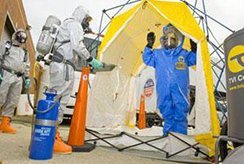Twenty Years of EPA Homeland Security Research – Looking Back and Moving Forward

Published September 7, 2021
The events of September 11, 2001, not only changed our view of the world but also the landscape of homeland security in the United States. Government leaders were determined to prepare for and respond to potential future attacks, so they laid out a plan to reorganize homeland security assets in the federal sphere.
As a key player in the nation’s response on September 11th and the subsequent Amerithrax events—when letters containing anthrax were mailed to the Senate Hart Building in Washington, D.C., and news media organizations in several cities—EPA examined its core mission of protecting public health and safeguarding the environment, as it relates to homeland security. Distinct and specified responsibilities were highlighted for EPA, including coordinating protection of the drinking water and wastewater sector; providing federal emergency response and recovery support in the event of a terrorist attack; providing forensic evidence collection assistance to law enforcement; conducting research for enhanced methods of detection and decontamination of biological and chemical warfare agents to support U.S. response efforts; and safeguarding EPA employees and facilities nationwide.
In support of the President’s National Strategy for Homeland Security, EPA developed a Homeland Security Strategy in 2002 that further described how EPA’s scientific and technical expertise could be used by the nation to prepare for, respond to, and recover from potential chemical, biological, or radiological attacks. In 2004, this spurred the establishment of EPA’s National Homeland Security Research Center (now part of the Homeland Security Research Program) to perform applied research and provide technical assistance for first responders and decision-makers within a rapid timeframe. Since its inception, the Homeland Security Research Program has built capability through a foundation of research to assist emergency responders and decision-makers through a number of incidents, such as ricin contamination, water contamination, the Fukushima Daiichi nuclear disaster, and Ebola outbreak of 2014. The program continues to develop capabilities to respond to large-scale contamination incidents and improve the ability of water utilities to prevent, prepare for, and respond to water contamination that threatens public health. As the program fulfills its mission by developing capabilities to enhance response to current events, such as the COVID-19 pandemic, fentanyl contaminations, and cyberattacks on critical infrastructure, it also looks to the future to apply what we know now to what could potentially come and ensure the United States is able to prepare for, respond to, and recover from any events that threaten public health.
Please join us on September 16 for a webinar that looks back at the last 20 years of EPA’s Homeland Security Research Program and moves forward into what the program is looking to do on the horizon: Webinar: Twenty Years of Homeland Security Research: How it Started and Where We Are Now
For a full history of EPA’s Homeland Security Research Program, please visit: Milestones in EPA's Homeland Security Research History
